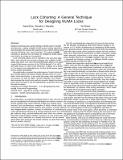Lock cohorting: A general technique for designing NUMA locks
Author(s)
Dice, David; Marathe, Virendra J.; Shavit, Nir N.
DownloadShavit_Lock cohorting.pdf (209.8Kb)
OPEN_ACCESS_POLICY
Open Access Policy
Creative Commons Attribution-Noncommercial-Share Alike
Terms of use
Metadata
Show full item recordAbstract
Multicore machines are quickly shifting to NUMA and CC-NUMA architectures, making scalable NUMA-aware locking algorithms, ones that take into account the machines' non-uniform memory and caching hierarchy, ever more important. This paper presents lock cohorting, a general new technique for designing NUMA-aware locks that is as simple as it is powerful.
Lock cohorting allows one to transform any spin-lock algorithm, with minimal non-intrusive changes, into scalable NUMA-aware spin-locks. Our new cohorting technique allows us to easily create NUMA-aware versions of the TATAS-Backoff, CLH, MCS, and ticket locks, to name a few. Moreover, it allows us to derive a CLH-based cohort abortable lock, the first NUMA-aware queue lock to support abortability.
We empirically compared the performance of cohort locks with prior NUMA-aware and classic NUMA-oblivious locks on a synthetic micro-benchmark, a real world key-value store application memcached, as well as the libc memory allocator. Our results demonstrate that cohort locks perform as well or better than known locks when the load is low and significantly out-perform them as the load increases.
Date issued
2012-02Department
Massachusetts Institute of Technology. Department of Electrical Engineering and Computer ScienceJournal
Proceedings of the 17th ACM SIGPLAN symposium on Principles and Practice of Parallel Programming (PPoPP '12)
Publisher
Association for Computing Machinery (ACM)
Citation
David Dice, Virendra J. Marathe, and Nir Shavit. 2012. Lock cohorting: a general technique for designing NUMA locks. In Proceedings of the 17th ACM SIGPLAN symposium on Principles and Practice of Parallel Programming (PPoPP '12). ACM, New York, NY, USA, 247-256.
Version: Author's final manuscript
ISBN
978-1-4503-1160-1